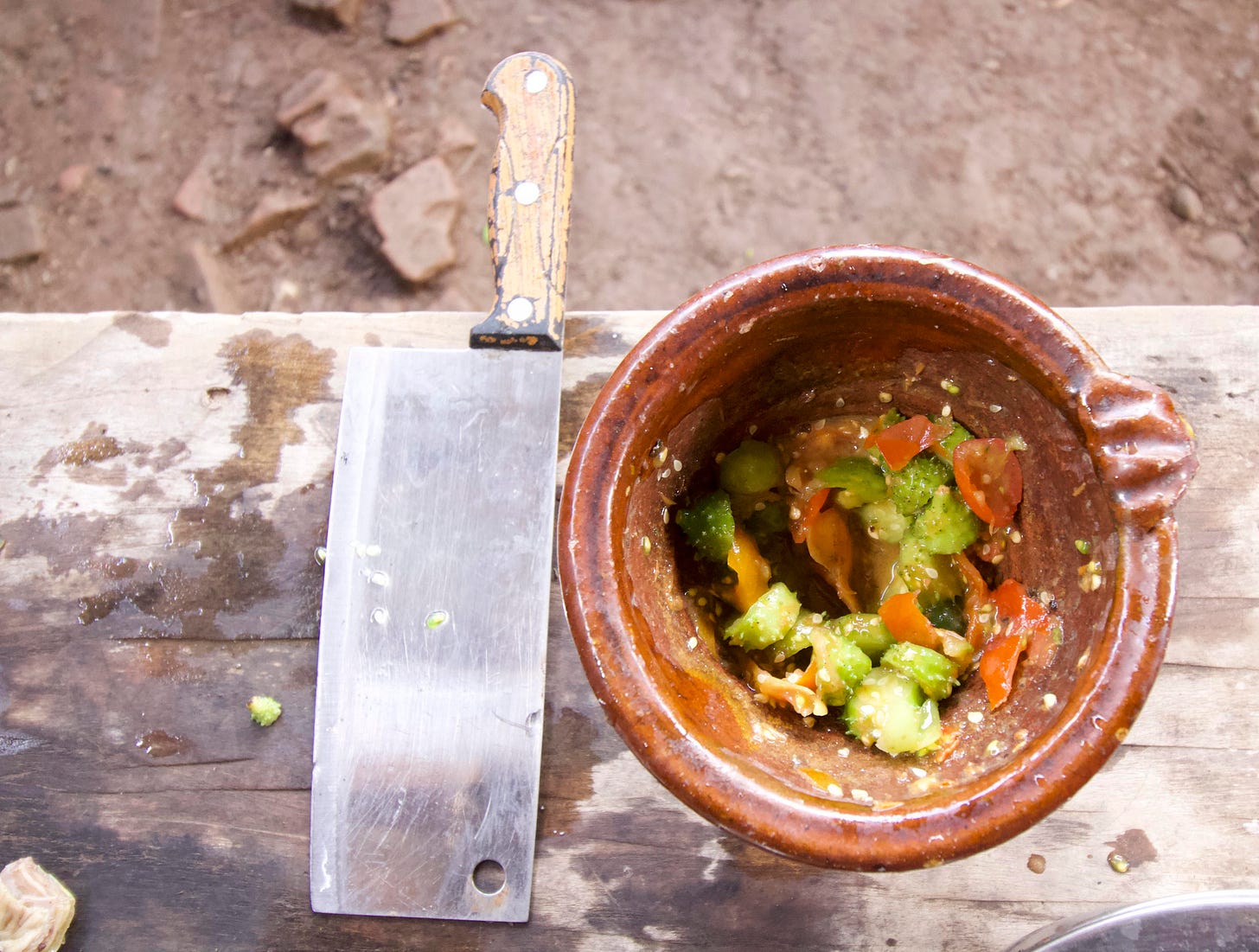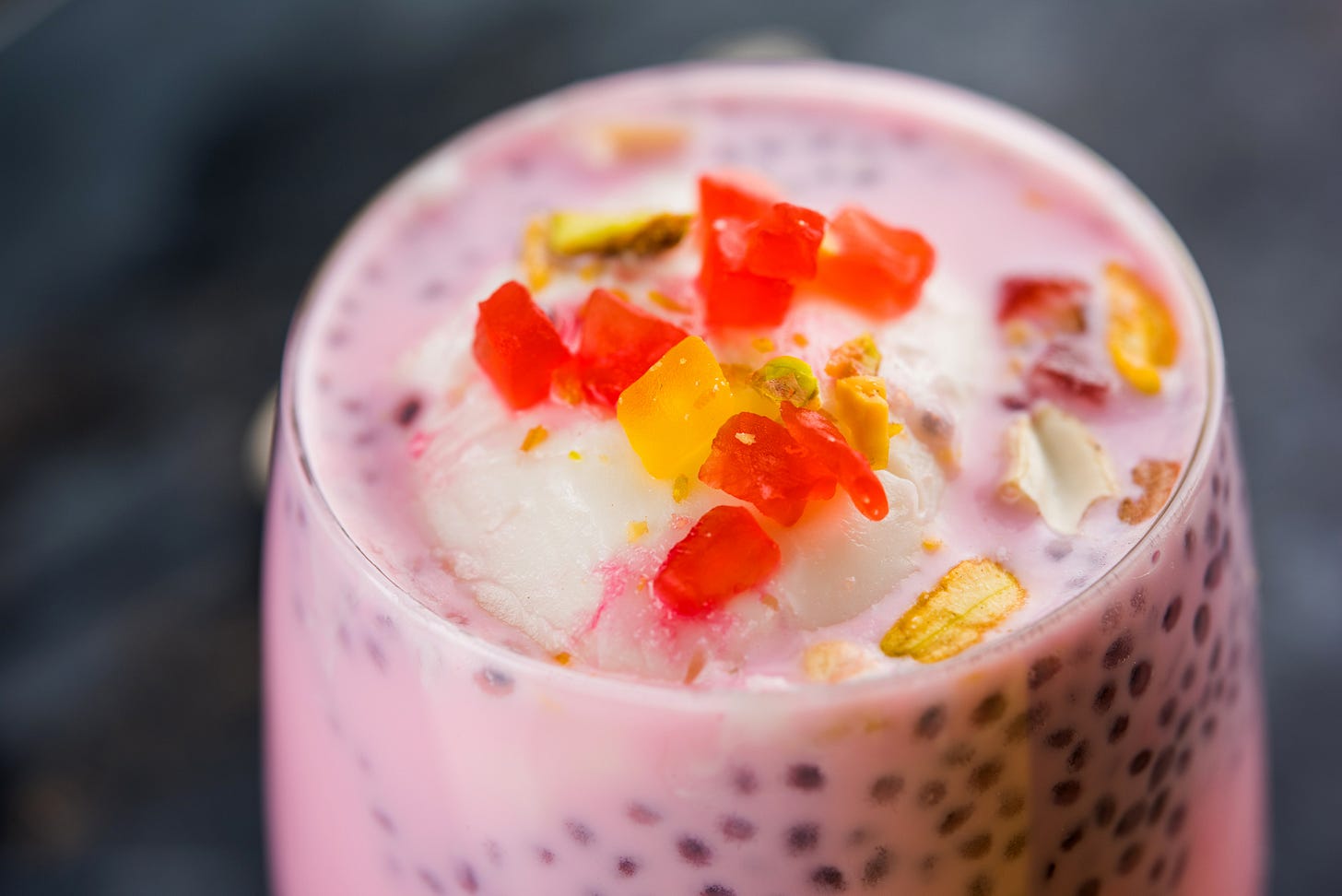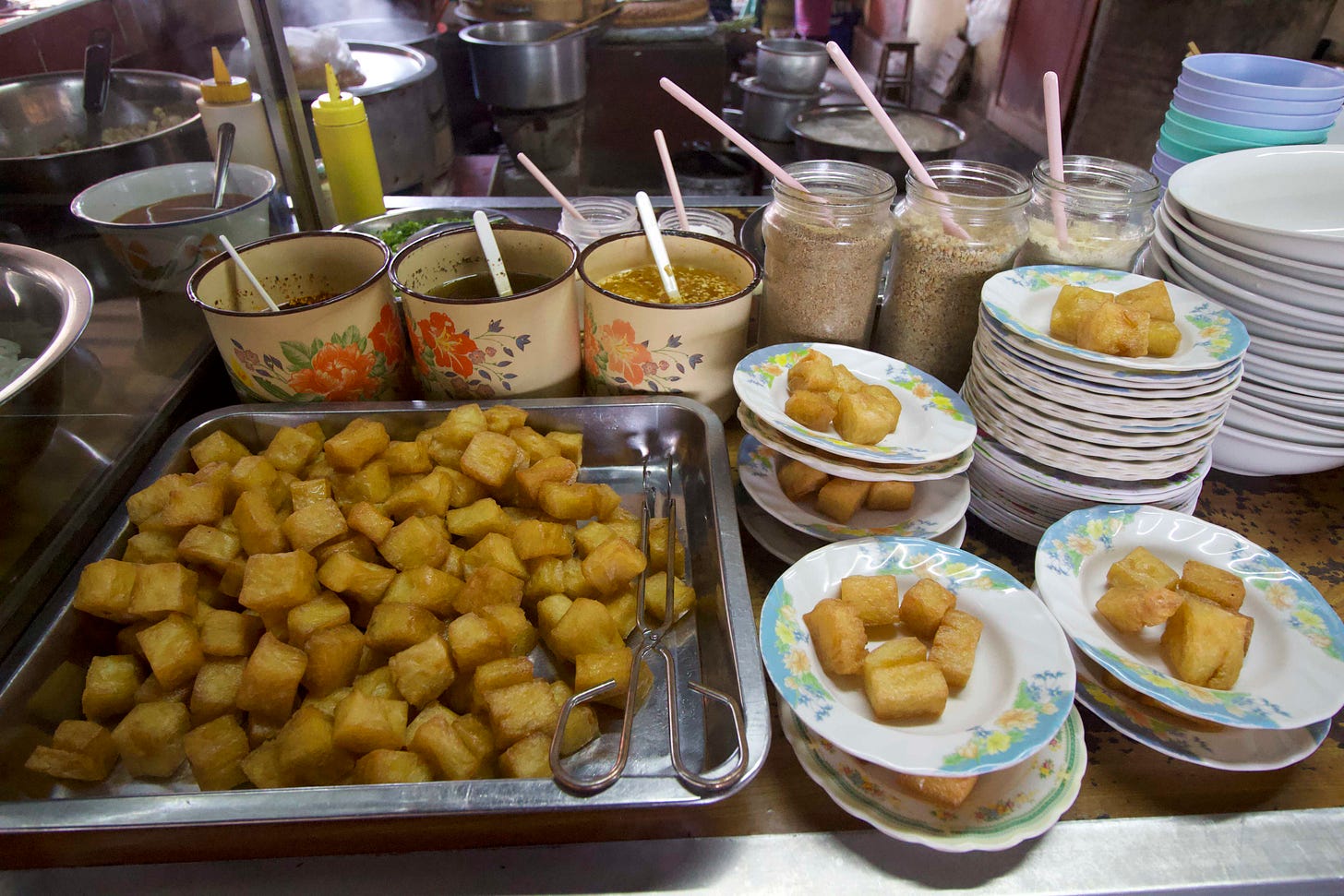A Very Personal Entry
Musings about home, family recipes and another tragic New Year under the dictatorship

I try not to mix my two hats - food and Burma/Myanmar - very much, but there are times when it’s inevitable. This week is one of them.
Thingyan, Myanmar’s traditional New Year Festival, began on Thursday and will end on Sunday. We will then usher in the year 1385 on Monday, Apr 17.
We often talk about new years as a time of renewal but in Myanmar, it really is about shedding the bad fortunes of the past year and welcoming a cool, clean and clear one, and we do this by splashing water over each other for three to four days.
It used to be the most festive event of the year and a highlight in most people’s calendars. Last year, I wrote about its history and how we normally celebrate it.
Unfortunately, Thingyan has taken on a very different hue since the military coup two years ago. It is no longer a joyous event and celebrations are limited mainly to those with links to the military.
This year has been particularly rough.
On Apr 11, the eve of the holidays, airstrikes by Myanmar’s military killed more than 160 civilians in the country’s centre. At least 20 of them were children. It has been dubbed the worst mass killing by the junta since it seized power on February 1, 2021.
On the same day, The Kite Tales, the non-profit storytelling project I set up with my friend Kelly, published an interview with a veteran healthcare worker who has been providing 3D prosthetics to her Myanmar patients who had lost limbs to farm accidents, car crashes, or increasingly, mortar blasts.
It was a sad twist of serendipity, so when I read about the Thingyan massacre, one of the first thoughts I had was how more people will need her help. If you are interested in supporting, we have a couple of suggestions here.
I had planned to write about my favourite family recipes in a nod to Thingyan but wavered when the latest tragedy happened. I wondered if it would be in bad taste to talk about something as mundane as eating when people back home are suffering atrocities that don’t bear thinking of.
Then I thought perhaps it is even more important now to write about things that bring us joy and to me, food = pleasure. Food is about love, peace, and friendship. I also remember how writing about - and cooking and eating - the foods I grew up with made the COVID-19 quarantine so much more enjoyable.
So I cut down my list of favourite recipes to two and forged ahead with another unusual issue where instead of food systems, I’ll just focus on the food.
Pretty In Pink

This is one of my absolute favourite desserts in the whole world. It brings back memories of hot and lazy April afternoons where we’d be taking a break between the morning and evening sessions of water throwing. I remember being happy, content, and chatting away with friends, family members and distant cousins.
We would cry with delight when my mum brought out small trays of colourful jellies because that’s usually a sign that she was about to make her famous signature dessert - faluda (ဖာလူဒါ).
This is a cold, pink and multi-layered sweet treat usually served in a glass. It is wonderful anywhere, but particularly delicious in the humid tropical heat of Myanmar. It has everything you’d want and more - ice cream, custard, jelly, basil seeds, sago pearls, rose water, and vermicelli noodles.
There are lots of variations. Some put condensed milk, others sugar syrup. Some add grass jelly, chopped candied fruits and nuts. The best ones are sweet without being cloying and chewy (from the jellies) without giving your jaw too much work!
Faluda originated in Persia, according to this 2016 NPR article from an Indian journalist who grew up with the dessert in India and discovered the Burmese version in Washington D.C.
“From there, it traveled to South Asia with Persian merchants and rulers who invaded the region. It is an essential taste of summer in many parts of South Asia. The snack has also traveled to nations in Southeast Asia, Africa and even South America.”
I love the fact that one of my favourite foods has its roots in a place thousands of kilometres away. I remember travelling all the way to downtown Yangon - I grew up in the suburbs - to a particularly well-known cafe to eat faluda. I’ve also had different versions at street side cafes that populate the town centre and run by owners of South Asian descent.
But of course, I love my mother’s pared down version best. The store-made ones may have a lot more ingredients but almost all that goes into her faluda is home-made and I would often have had a hand in making them.
Enter “faluda” or “falooda” in Google - or Duck Duck Go for the cool kids among us - and you’ll find hundreds of pictures of the tantalising dessert and how to make it. But below is my mother’s version. She uses a tall glass because that means more faluda.
Ingredients:
Coloured agar-agar (or Jello)
Custard pudding
Boiled whole milk
Vanilla ice cream
A little sugar
Rose water
Preparation
- Dissolve a pack of agar-agar in boiling water until it thickens. Divide into three cups, add a different colour to each cup and refrigerate. My mum usually goes for orange, red and green.
- To make custard pudding, follow this easy recipe from Cooking with Dog (it’s a YouTube cooking show with a Japanese chef and his canine friend). We use only milk and eggs so this is the closest to how we make it at home. But instead of special cups, we just put them in normal bowls and refrigerate until assembly time.
- Boil the whole milk until it becomes a little thick.
- To assemble - put two tablespoons each of coloured agar agar in a tall glass, two tablespoons of custard pudding, and a scoop (or two) of vanilla ice cream. Either add a pinch of sugar or use sugar dissolved in water, depending on your taste. Fill up the glass with boiled whole milk then top it up with a teaspoon of rose water.
A Great Aunt’s Legacy
Nga Pi Chet (ငါးပိချက်) is a quintessential Bamar dish - fresh, punchy, has two key foundational ingredients of our curries (shallots and tomatoes) and features our beloved ‘nga pi’. This fermented fish delicacy evokes reactions akin to blue cheese, durian, Icelandic hákarl or Vegemite. Meaning, aficionados swear by it but haters gonna hate.
Another one of my all-time favourite dishes also has nga pi. Buy a good quality one, which usually comes in a paste form, and mix a couple of tablespoons of nga pi with hot water and chilli flakes. We eat that with rice and fresh or boiled vegetables.
Like a beloved member of our household said in this Kite Tale story, some people would be snobbish about this dish because it’s considered a poor man’s food, but my sister and I grew up loving it and devouring it, as did our dad.
Back to nga pi chet.
Nga pi chet is often relegated to side dish status but I am perfectly happy with a good bowl of nga pi chet and freshly cooked rice. It is one of my ultimate comfort foods and another favourite of my dad’s too.
Every household has their own special version but my great aunt’s recipe was so good, Ludu Daw Amar, one of Myanmar’s most celebrated writers, waxed lyrical about it in a magazine article in the 1990s. But I didn’t know about this until someone alerted me to it in 2016.
So I asked her about it when I was in Mandalay, Myanmar’s second largest city and where my maternal grandparents came from, later that year. By then, my great aunt was 96 and she has entrusted her recipe to one of her granddaughters.
That afternoon, as my cousin bustled about us cooking this famous dish and Kelly did the hard work of filming it, I sat next to my still-amazingly-lucid great aunt in the courtyard and chatted with her about everything and anything.
I’m so glad I had a chance to catch up with her, not only because we came away full and happy. That was the last time I saw her. She passed away nine months later.
If you’re interested in making this at home and the little video above isn’t sufficient, you can find the full recipe here.
Home, Food and Mixed Feelings
I may have said this before - one of my earliest memories is of opening the refrigerator at home and being awed by all the amazing stuff inside.
There were meat in tightly packed plastic bags in the freezer. In the middle compartments, jams, butter and water bottles jostled for space with more traditional ingredients like yogurt in earthenware jars and leftover curries. Fruits, vegetables and fragrant coriander - the latter wrapped in newspaper - filled the bottom drawer.
I think my love affair with food started right there and then. The sheer act of eating good food reminds me of home and my childhood. I’m also convinced this is why all my fridges look like I’m preparing for doomsday.
Now both my personal and professional life revolves around food. My upbringing in Myanmar definitely contributed to how I see the debates raging around hunger, nutrition and the power imbalances inherent in our current food systems.
It has also made me acutely aware of how fortunate my family is. Obviously I wish we all live closer instead of in different countries, like we would be if we were still living in Myanmar. But we were able to leave when it became apparent it was no longer safe or good for our future.
We’ve all made decent lives for ourselves but leaving comes with its own - although admittedly much smaller - package of loss and a large dose of survivor’s guilt. I’ve also unwittingly become an exile for a second time. Every time I see my blood-red passport, I wonder when and whether I’ll see some of my loved ones again.
So I cook and I eat and I feed others flavours from home, spreading the taste of Myanmar as far as I can muster. I have a feeling I’ll be doing that again this weekend, as another Burmese year comes to a close.
Three Good Reads
The war on Tigray wiped out decades of environmental progress: how to start again - The Conversation
Two Ethiopian scientists, Aster Gebrekirstos and Emiru Birhane, highlighted an often-overlooked aspect of the brutal war in Ethiopia’s Tigray region - how it affected the much-lauded and much-needed land restoration efforts and what needs to be done to bring them back on track.
In an area where “agriculture contributes 42.7% to GDP, about 85% of employment and 70% of export earnings”, denuded landscapes can have terrible impacts for both the immediate and long-term future.
I visited Tigray in February 2019 and wrote about how these efforts are helping to shift the image of Tigray from being a poster child of famine to one of resilience. So it’s heartbreaking to see all that hard work destroyed by war.
Food on the picket line - Vittles
“We need stories just as we need to eat, and as Britain’s labour power has expressed itself in increasing vitality in this last year, I’ve seen workers of all stripes creating their own stories of struggle and solidarity as they break bread, not strikes, on the picket line,” wrote trade unionist and Wakefield resident Gareth Forest in this piece about finding solidarity through food during protests and strikes.
Vittles is one of my favourite newsletters and you have to subscribe to read this but it’s so worth it, particularly if you live in the UK. But they also have great posts on food in France and their latest ones cover restaurants in LA.
Anticipate and Localize: Leveraging Humanitarian Funding To Create More Sustainable Food Systems - The Rockefeller Foundation
This is a 72-page report instead of a news article so you’ll need the whole weekend to go through it.
But if you’re in the development world and interested in ending hunger, it gives practical suggestions to donors on how to “align more closely with solutions that strengthen food system resilience to climate change, conflict, and other shocks”.
Full disclosure, I was part of the Convening Group whose discussions and suggestions made it into the report.
As always, please feel free to share this post and send tips and thoughts on mastodon @ThinInk@journa.host, my LinkedIn page, twitter @thinink, or via e-mail thin@thin-ink.net.








Beautiful. Thank you